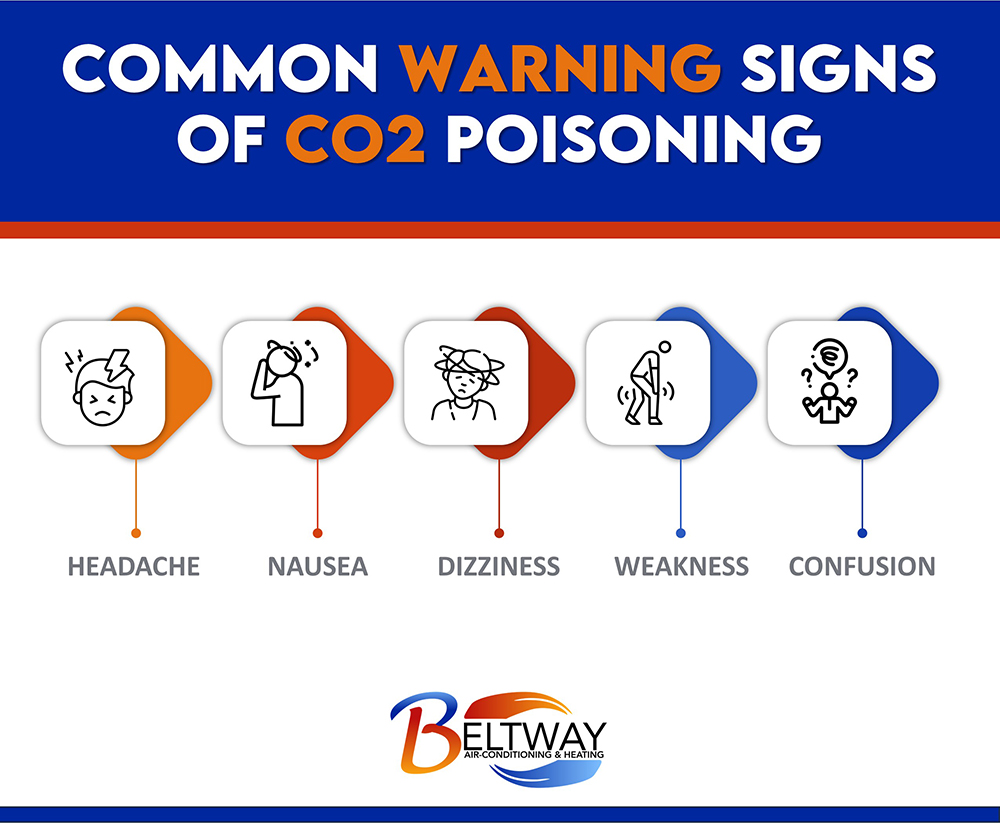Though we often take precautions to keep ourselves and our homes safe, like child-proofing before a new infant or putting fresh batteries in smoke alarms, one measure often slips peoples’ minds: carbon monoxide detectors. At Beltway Air Conditioning, Heating & Plumbing, we want to help keep you and your Hanover family as safe as possible, including when it comes to carbon monoxide, or CO2. Read on for a rundown of carbon monoxide, CO2 detectors, and how they can impact your home.
What Is Carbon Monoxide?
Carbon monoxide is a dangerous gas that has no color, odor, or taste. When present, you likely will not notice it without some type of detection system, though some areas add a compound that smells like rotten eggs to help residents detect it. CO2 gas is flammable and can cause serious health issues when inhaled in high amounts.
How Does Carbon Monoxide Get Into Our Homes?
Carbon monoxide is released by burning fuels such as gasoline, natural gas, oil, kerosene, and charcoal. This gas often accumulates in poorly ventilated areas and from improperly installed situations.
Some of the top sources of carbon monoxide in the home include:
- Gas appliances such as your stove, dryer, furnace, or water heater
- Gas or wood fireplaces
- Coal or oil furnaces
- Wood stoves
- Space heaters
- Oil or kerosene heaters
- Charcoal grills and camp stoves
- Automobile exhaust fumes (especially dangerous in a closed garage)
How Can I Lower the Risk of Carbon Monoxide Poisoning?
When you know where carbon monoxide comes from, you can arm yourself with education and take steps to improve your home’s safety.
Some of the best ways to lower the risk of carbon monoxide poisoning in your home include:
- Be sure all appliances are properly installed and vented
- Have your furnace and fireplace inspected annually by a professional
- Ensure your outdoor air intake for your furnace is not blocked
- Do not burn charcoal inside your home
- Never operate gas-powered engines in an enclosed space
- Do not leave your car running inside the garage
What Effects Does Carbon Monoxide Have on Health?
Some of the most common warning signs of CO2 poisoning are:
- Headache
- Nausea
- Dizziness
- Weakness
- Confusion & disorientation

At higher levels in your home, carbon monoxide poisoning becomes very dangerous and can lead to serious illness, permanent mental and physical disability, and even death. Because you cannot see, smell, or taste the gas inside your home, many people don’t recognize carbon monoxide poisoning until it is too late.
Here are just some of the symptoms of high levels of carbon monoxide:
- Sleepiness
- Nausea & vomiting
- Anxiety or depression
- Confusion & disorientation
- Impaired vision
- Impaired coordination
Statistics show that more than 50,000 people visit emergency rooms every year for carbon monoxide poisoning, with over 400 deaths annually.
How Do I Know if Carbon Monoxide Levels Are Too High?
Having Beltway Air Conditioning, Heating & Plumbing install carbon monoxide detectors inside your home is the best way to be alerted to dangerous levels of carbon monoxide. You will not see, smell, or taste carbon monoxide at any level, so you need a detection system to monitor and alert you to its presence.
How Does a Carbon Monoxide Detector Work?
Carbon monoxide detectors are designed to measure the amount of carbon monoxide inside your home. There are different types of detectors that do this in different ways. Most devices work based on a chemical reaction occurring when levels are high enough to be dangerous. This monitoring happens continuously to constantly be on the lookout for carbon monoxide. The detection system then alerts you to the presence of higher-than-safe amounts of the gas.
Where Should I Install Detectors?
The National Fire Protection Association (NFPA) recommends having a carbon monoxide detector installed on every floor of the home and in a central location outside of each room where people sleep. There may also be local or state codes where you live that dictate placement and the number of detectors required in your home. Be sure to remember the basement and attic if applicable.
When installing your carbon monoxide detectors, first consult the manufacturer’s information. Some detectors should be mounted to the ceiling, while others are best installed on the wall a few feet lower than the ceiling.
Are There Different Types of Carbon Monoxide Detectors?
There are several different types of carbon monoxide detectors available. You may decide to choose one over the other based on your personal circumstances.
Battery-powered devices are portable and can be installed easily anywhere in your home.
Hardwired detectors are connected to your home’s power source and will continuously monitor the gas level in your home at all times when electricity is on.
Combination units use both battery and electrical power, using one source as a backup method if the other power source fails.
Most carbon monoxide detectors have an audible alarm that will sound continuously until manually turned off or the threat has diminished. There are also monitors with a digital display that show the level of carbon monoxide.
What Maintenance Is Needed for Carbon Monoxide Detectors?
Similar to smoke detectors, there are measures you should take to ensure your unit is still protecting you and your family.
Test your carbon monoxide detectors regularly to ensure they are still functioning properly. Most detectors have a test button on them. If you’re using a battery-powered unit, the batteries should be replaced at least once per year or as instructed by the manufacturer.
Regardless of type, your carbon monoxide detectors should be replaced with new units after several years, as dictated by the manufacturer of your specific model.
What Should I Do If My Carbon Monoxide Detector Goes Off?
If your carbon monoxide detector indicates a high level of the poisonous gas in your home, you should immediately leave the area. Step outside for fresh air and call 911. Seek medical attention for anyone displaying signs and symptoms of carbon monoxide poisoning.
Now that you understand what carbon monoxide is and how dangerous it can be, it’s time to make sure you have carbon monoxide detectors in your home. These detectors should be appropriate for your space and needs for best results. They also need to be installed properly in order to work correctly.
The best way to ensure proper installation and functioning of your carbon monoxide detectors is to call a professional. A trained and knowledgeable technician will know what type of detector is best for your home, where to install them, and how to install them. For this type of professional service, call Beltway Air Conditioning, Heating & Plumbing today. We’ll schedule a time to install units in your home and teach you how they work.




